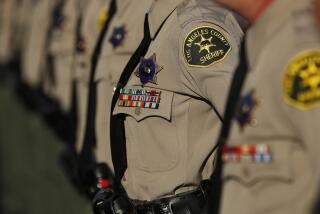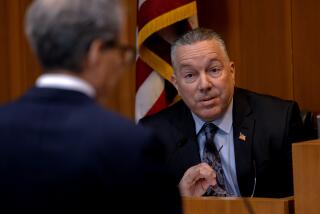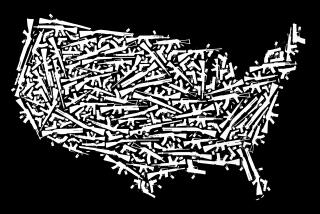Emails show top Justice Department officials knew of ATF gun program
- Share via
Reporting from Washington — Senior Justice Department officials were aware that ATF agents allowed firearms to be “walked” into Mexico, according to a series of emails last year in which they discussed two undercover operations on the Southwest border, including the failed Fast and Furious program.
In the emails that the department turned over to congressional investigators, Justice Department officials last October discussed both the Fast and Furious gun-trafficking surveillance operation in Phoenix and a separate investigation from 2006 and 2007 called Operation Wide Receiver. In Wide Receiver, which took place in Tucson, firearms also were acquired by illegal straw purchasers and lost in Mexico, the emails say.
The term “gun walking” is central to the failure of Fast and Furious. Agents with the federal Bureau of Alcohol, Tobacco, Firearms and Explosives purposely allowed licensed firearms dealers to sell weapons to illegal straw buyers, hoping to track the guns to Mexican drug cartel leaders and arrest them. But they lost track of more than 2,000 weapons, and the Mexican government says some of them have turned up at about 170 crime scenes there. Two were recovered at the scene of a U.S. Border Patrol agent’s slaying in Arizona in December.
Justice Department officials have said repeatedly that they knew nothing of Fast and Furious tactics until ATF whistle-blowers went public this year with allegations that guns were being illegally purchased with the ATF’s knowledge.
Justice Department officials, who asked not to be identified because of the ongoing investigations into Fast and Furious, said that although senior department officials knew that guns were “walked” in the Wide Receiver investigation, they were unaware that ATF agents were using similar tactics in Fast and Furious.
Jason Weinstein, deputy attorney general in the criminal division, brought up both cases in an October 2010 email, apparently concerned that they were going to overlap.
“Do you think we should try to have Lanny participate in press when Fast and Furious and [the] Tucson case are unsealed?” he asked about his boss, Lanny A. Breuer, head of the criminal division. “It’s a tricky case given the number of guns that have walked but it is a significant set of prosecutions.”
James Trusty, acting chief of the department’s organized crime and gang section, responded, “I think so but the timing is tricky too.”
He said the Tucson case would be ready for indictments before Fast and Furious, and that “it’s not clear how much we’re involved in the main F and F case.”
Either way, he added that “it’s not going to be any big surprise that a bunch of US guns are being used in MX, so I’m not sure how much grief we get for ‘guns walking.’ It may be more like, ‘Finally they’re going after people who sent guns down there’ ”
Investigators working for Rep. Darrell Issa (R-Vista), chairman of the House Committee on Oversight and Government Reform, and Sen. Charles E. Grassley of Iowa, the top Republican on the Senate Judiciary Committee, view the emails as strong evidence that Justice Department officials knew about “gun walking” tactics in Fast and Furious.
Fast and Furious ran from fall 2009 to January, culminating in charges against 20 people — none of them cartel leaders. It was unclear whether any indictments were issued in the Wide Receiver operation.
July 2010 memos, part of weekly reports, discussed an illegal straw purchaser in Fast and Furious who bought 1,500 weapons “that were then supplied to Mexican drug-trafficking cartels.”
October and November memos said that “Phoenix-based ‘Operation Fast and Furious’ is ready for takedown” — several months before the investigation was officially closed.
Copies of all of the memos were heavily redacted.
Justice Department officials said Atty. Gen. Eric H. Holder Jr. routinely received reports about myriad ongoing investigations around the country, and that the reports did not disclose that ATF agents were purposely “walking” the weapons. They said Issa received a similar Fast and Furious update last year.
But congressional investigators said the memos suggested Holder had hedged what he knew.
According to the emails, Holder was told generally about Fast and Furious in the memos in July, October and November 2010, well before he told congressional committees he had first learned of the program.
On March 10, Holder testified before a Senate subcommittee that he had just learned about the Fast and Furious gun-walking allegations and had asked for the inspector general’s investigation. “We cannot have a situation where guns are allowed to walk,” he said.
On May 3, he was asked by Issa when he first learned about Fast and Furious. “I’m not sure of the exact date,” Holder testified. “But I probably heard about Fast and Furious for the first time over the last few weeks.”
Justice Department officials said Holder was referring to the date when he first learned about the operational details of Fast and Furious, not the program itself.
More to Read
Sign up for Essential California
The most important California stories and recommendations in your inbox every morning.
You may occasionally receive promotional content from the Los Angeles Times.











